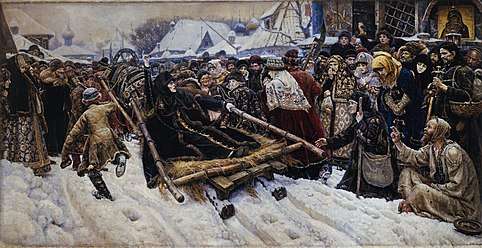Feodosia Morozova
Feodosia Prokopiyevna Morozova (Russian: Феодо́сия Проко́пьевна Моро́зова) (21 May 1632 – 1 December 1675) was one of the best-known partisans of the Old Believer movement[E 1][R 1]. She was perceived as a martyr after she was arrested and died in prison.

Life
She was born on May 21, 1632 into a family of the okolnichy Prokopy Feodorovich Sokovnin. At the age of 17, she was married to the boyar Gleb Morozov, brother to the tsar's tutor Boris Morozov, one of the wealthiest men in Russia and brother-in-law of Tsar Alexis. Feodosia bore one child to Gleb, a son, Ivan. After her husband's early death in 1662, she retained a prominent position at the Russian court as a lady-in-waiting to Tsarina Maria. She also inherited vast wealth, which she administered on behalf of her son Ivan.
During the Raskol, because Archpriest Avvakum was her confessor, Feodosia joined the Old Believers' movement and secretly took monastic vows with the name Theodora[E 2]. She played an important role in convincing her sister, Princess Evdokia Urusova, to join the Old Believers. They were also joined by fellow noblewoman Maria Danilova.[E 3] Following Avvakum, she rejected the reforms of Patriarch Nikon insisting he had no authority in the church to alter established practices, identifying such innovations with the corruption of the faith by the antichrist[E 4].
After many misfortunes the two sisters and Danilova were arrested by order of Tsar Alexis of Russia in 1671. They were interrogated and tortured over a long period, but refused to recant. Attempts to reach a compromise led by Patriarch Pitirim were also rejected. While she was under arrest, her son Ivan died.
Alexis contemplated having Morozova burned at the stake, but was dissuaded. Instead she and the others were incarcerated in an underground cellar of the St. Paphnutius Monastery at Borovsk, where they endured considerable deprivations[R 2]. After the appointment of a new Patriarch, Ioakim, they were deprived of all support and were slowly starved. All three succumbed to starvation, in 1675, with Morozova dying on November 2[E 3].
Reputation

Avvakum wrote a "Lament for the three martyrs". A hagiography, Tale of Boiarynia Morozov[R 3], by an unknown author, gave an account of her life as a martyr. The story circulated widely and miracles were attributed to Morozova by Old Believers. Many Old Believer communities continue to venerate her as a martyr.[E 3]
Nevertheless, her reputation was limited until Morozova's role as a representative of Russian identity and tradition became important to nationalist writers in the 19th century. She became a household name after being discussed by important Russian writers and depicted by Vasily Surikov. She was also taken as a heroine by some radical groups, who saw her as a symbol of resistance to state power. The People's Will revolutionary movement promoted her, and her virtues were praised by writers of the Soviet era such as Anna Akhmatova, Varlam Shalamov and Fazil Iskander, who "symbolically enlisted her in their own causes of resistance".[E 3]
A chapel was constructed in 2002 on the site of the prison where Morozova died.
References
Publications that are available in English:
- Daniil Ermokhin (October 22, 2018). "Boyarinya Morozova". www.rpsc.ru. Moscow: The Russian Orthodox Old Believer Church. The official website of the Moscow Metropolitanate. Retrieved November 2, 2019. (on Russian)
- ""Boyarina Morozova", The state Tetyakov Gallery". Archived from the original on March 12, 2016. Retrieved November 2, 2019.
- Nadieszda Kizenko (2004). "Review of Margaret Ziolkowski, ed. Tale of Boiarynia Morozova: A Seventeenth-Century Religious Life". www.h-net.org. H-Net: Humanities & Social Sciences Online. Retrieved November 2, 2019.
- Ziolkowski, Margaret (2000). Tale of Boiarynia Morozova: A Seventeenth-century Religious Life. Lanham, MD: Lexington Books. pp. 10–11. ISBN 978-0-7391-0177-3.
Publications that are only available in Russian:
- Ageeva, Е.А (2013). "Feodosia Prokopiyevna Morozova [Морозова Феодосия Прокопьевна]". Great Russian Encyclopedia (in Russian). 21. Mongols - Nanomaterials. Scientific publishing house "Great Russian Encyclopedia". p. 141. ISBN 978-5-85270-355-2. Retrieved November 2, 2019.
- Kirill Kozhurin (2012). Boyar Morozova [Боярыня Морозова]. The Life of Wonderful People, Small Series, Issue 38 (in Russian). Moscow: Молодая гвардия. p. 382. ISBN 978-5-235-03559-1. Retrieved November 2, 2019.
- Mazunin A (1979). The Tale of Boyar Morozova [Повесть о боярыне Морозовой] (in Russian). Leningrad: Science [Наука]. p. 226. ISBN 978-5-235-03559-1. Retrieved November 2, 2019. The Tale